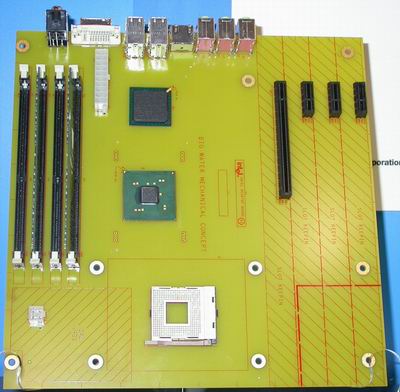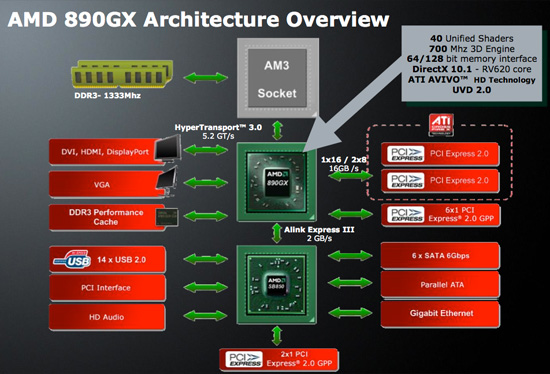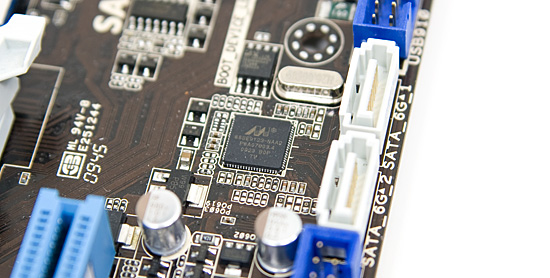6Gbps SATA Performance: AMD 890GX vs. Intel X58/P55
by Anand Lal Shimpi on March 25, 2010 12:00 AM EST- Posted in
- Storage
The Primer: PCI Express 1.0 vs. 2.0
A serial interface, PCI Express is organized into lanes. Each lane has an independent set of transmit and receive pins, and data can be sent in both directions simultaneously. And here’s where things get misleading. Bandwidth in a single direction for a single PCIe 1.0 lane (x1) is 250MB/s, but because you can send and receive 250MB/s at the same time Intel likes to state the bandwidth available to a PCIe 1.0 x1 slot as 500MB/s. While that is the total aggregate bandwidth available to a single slot, you can only reach that bandwidth figure if you’re reading and writing at the same time.

One of our first encounters with PCI Express was at IDF in 2002
PCI Express 2.0 doubles the bidirectional bandwidth per lane. Instead of 250MB/s in each direction per lane, you get 500MB/s.
Other than graphics, there haven’t been any high bandwidth consumers on the PCIe bus in desktops. Thus the distinction between PCIe 1.0 and 2.0 has never really mattered. Today, both USB 3.0 and 6Gbps SATA aim to change that. Both can easily saturate a PCIe 1.0 x1 connection.

Intel's X58 Chipset. The only PCIe 2.0 lanes come from the IOH.
This is a problem because all Intel chipsets have a combination of PCIe 1.0 and 2.0 slots. Intel’s X58 chipset for example has 36 PCIe 2.0 lanes off of the X58 IOH, plus an additional 6 PCIe 1.0 lanes off the ICH. AMD’s 7 and 8 series chipsets don’t have any PCIe 1.0 slots.

AMD's 890GX doesn't have any PCIe 1.0 lanes
No desktop chipset natively supports both 6Gbps SATA and USB 3.0. AMD’s 8-series brings native 6Gbps SATA support, but USB 3 still requires an external controller. On Intel chipsets, you need a separate controller for both 6Gbps SATA and USB 3.
These 3rd party controllers are all PCIe devices, just placed on the motherboard. NEC’s µPD720200 is exclusively used by all motherboard manufacturers for enabling USB 3.0 support. The µPD720200 has a PCIe 2.0 x1 interface and supports two USB 3.0 ports.
The USB 3 spec calls for transfer rates of up to 500MB/s. Connected to a PCIe 2.0 interface, you get 500MB/s up and down, more than enough bandwidth for the controller. However if you connect the controller to a PCIe 1.0 interface, you only get half that (and even less in practice). It’s not a problem today but eventually, with a fast enough USB 3 device, you’d run into a bottleneck.
The 6Gbps situation isn’t any better. Marvell’s 88SE91xx PCIe 2.0 controller is the only way to enable 6Gbps SATA on motherboards (other than 890GX boards) or add-in cards today.

The interface is only a single PCIe 2.0 lane. The 6Gbps SATA spec allows for up to 750MB/s of bandwidth, but the PCIe 2.0 x1 interface limits read/write speed to 500MB/s. Pair it with a PCIe 1.0 x1 interface and you’re down to 250MB/s (and much less in reality due to bus overhead).










57 Comments
View All Comments
vol7ron - Thursday, March 25, 2010 - link
It would be extremely nice to see any RAID tests, as I've been asking Anand for months.I think he said a full review is coming, of course he could have just been toying with my emotions.
nubie - Thursday, March 25, 2010 - link
Is there any logical reason you couldn't run a video card with x15 or x14 links and send the other 1 or 2 off to the 6Gbps and USB 3.0 controllers?As far as I am concerned it should work (and I have a geforce 6200 modified to x1 with a dremel that has been in use for the last couple years).
Maybe the drivers or video bios wouldn't like that kind of lane splitting on some cards.
You can test this yourself quickly by applying some scotch tape over a few of the signal pairs on the end of the video card, you should be able to see if modern cards have any trouble linking at x9-x15 link widths.
nubie - Thursday, March 25, 2010 - link
Not to mention, where are the x4 6Gbps cards?wiak - Friday, March 26, 2010 - link
the marvell chip is a pcie 2.0 x1 chip anyway so its limited to that speed regardless of interface to motherboardatleast this says so
https://docs.google.com/viewer?url=http://www.marv...">https://docs.google.com/viewer?url=http..._control...
same goes for USB 3.0 from NEC, its also a PCIe 2.0 x1 chip
JarredWalton - Thursday, March 25, 2010 - link
Like many computer interfaces, PCIe is designed to work in powers of two. You could run x1, x2, x4, x8, or x16, but x3 or x5 aren't allowable configurations.nubie - Thursday, March 25, 2010 - link
OK, x12 is accounted for according to this:http://www.interfacebus.com/Design_Connector_PCI_E...">http://www.interfacebus.com/Design_Connector_PCI_E...
[quote]PCI Express supports 1x [2.5Gbps], 2x, 4x, 8x, 12x, 16x, and 32x bus widths[/quote]
I wonder about x14, as it should offer much greater bandwidth than x8.
I suppose I could do some informal testing here and see what really works, or maybe do some internet research first because I don't exactly have a test bench.
mathew7 - Thursday, March 25, 2010 - link
While 12x is good for 1 card, I wonder how feasible would 6x do for 2 gfx cards.nubie - Thursday, March 25, 2010 - link
Even AMD agrees to the x12 link width:http://www.amd.com/us-en/Processors/ComputingSolut...">http://www.amd.com/us-en/Processors/Com.../0,,30_2...
Seems like it could be an acceptable compromise on some platforms.
JarredWalton - Thursday, March 25, 2010 - link
x12 is the exception to the powers of 2, you're correct. I'm not sure it would really matter much; Anand's results show that even with plenty of extra bandwidth (i.e. in a PCIe 2.0 x16 slot), the SATA 6G connection doesn't always perform the same. It looks like BIOS tuning is at present more important than other aspects, provided of course that you're not an x1 PCIe 1.0.iwodo - Thursday, March 25, 2010 - link
Well we are speaking in terms of Gfx, with So GFX card work instead of 16x, work in 12x. Or even 10x. Thereby saving IO space,just wondering what are the status of PCI-E 3.0....